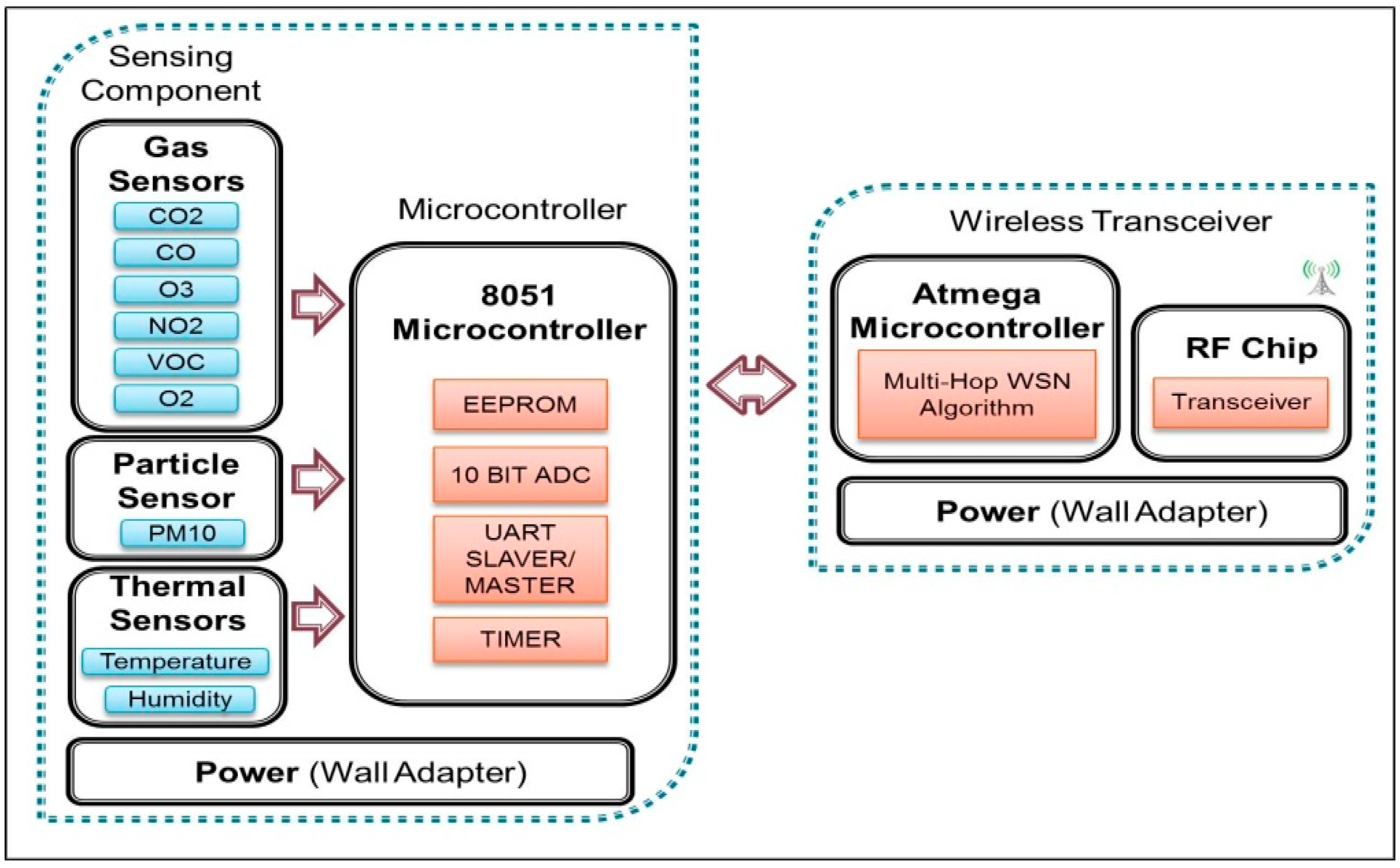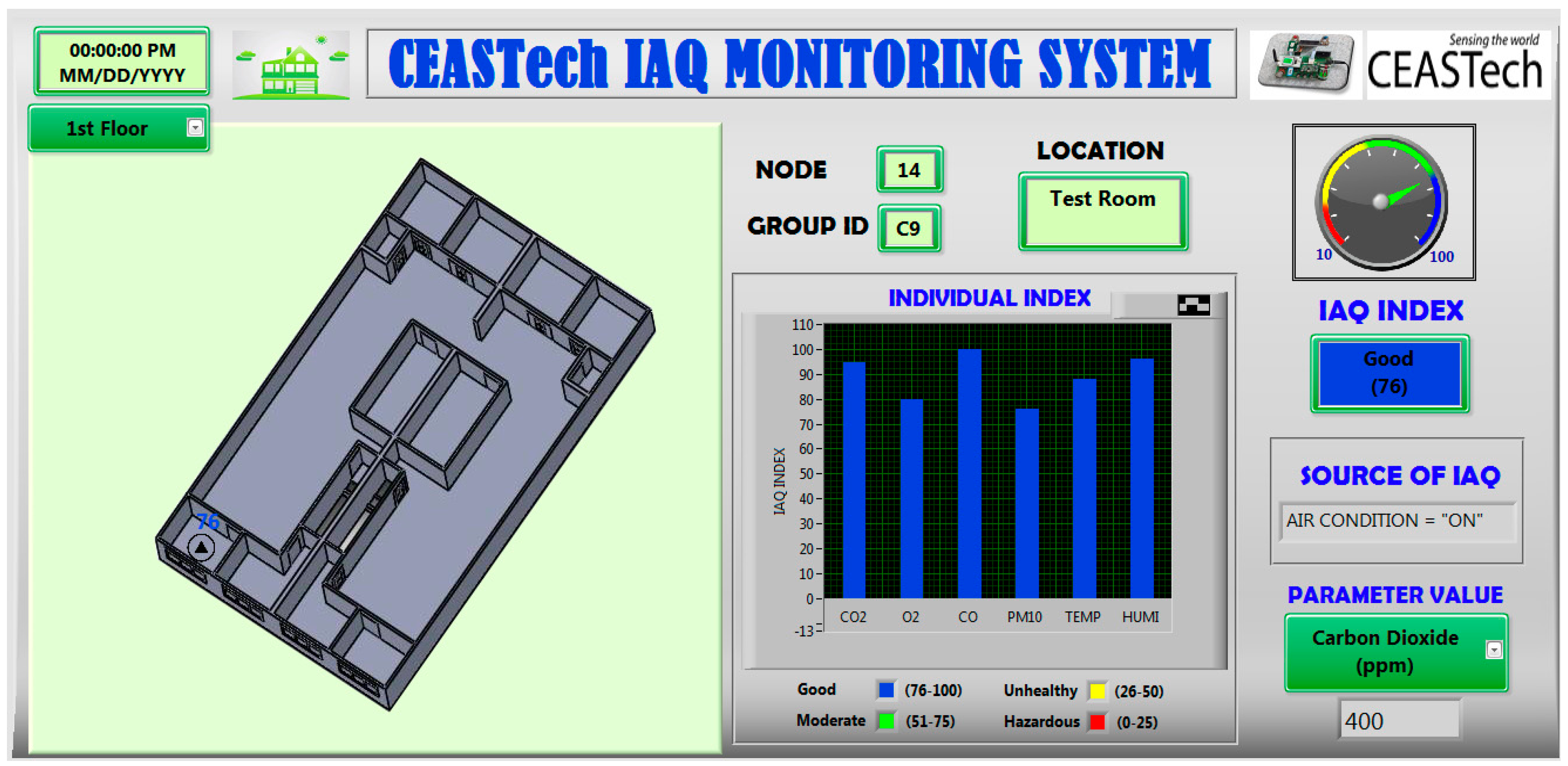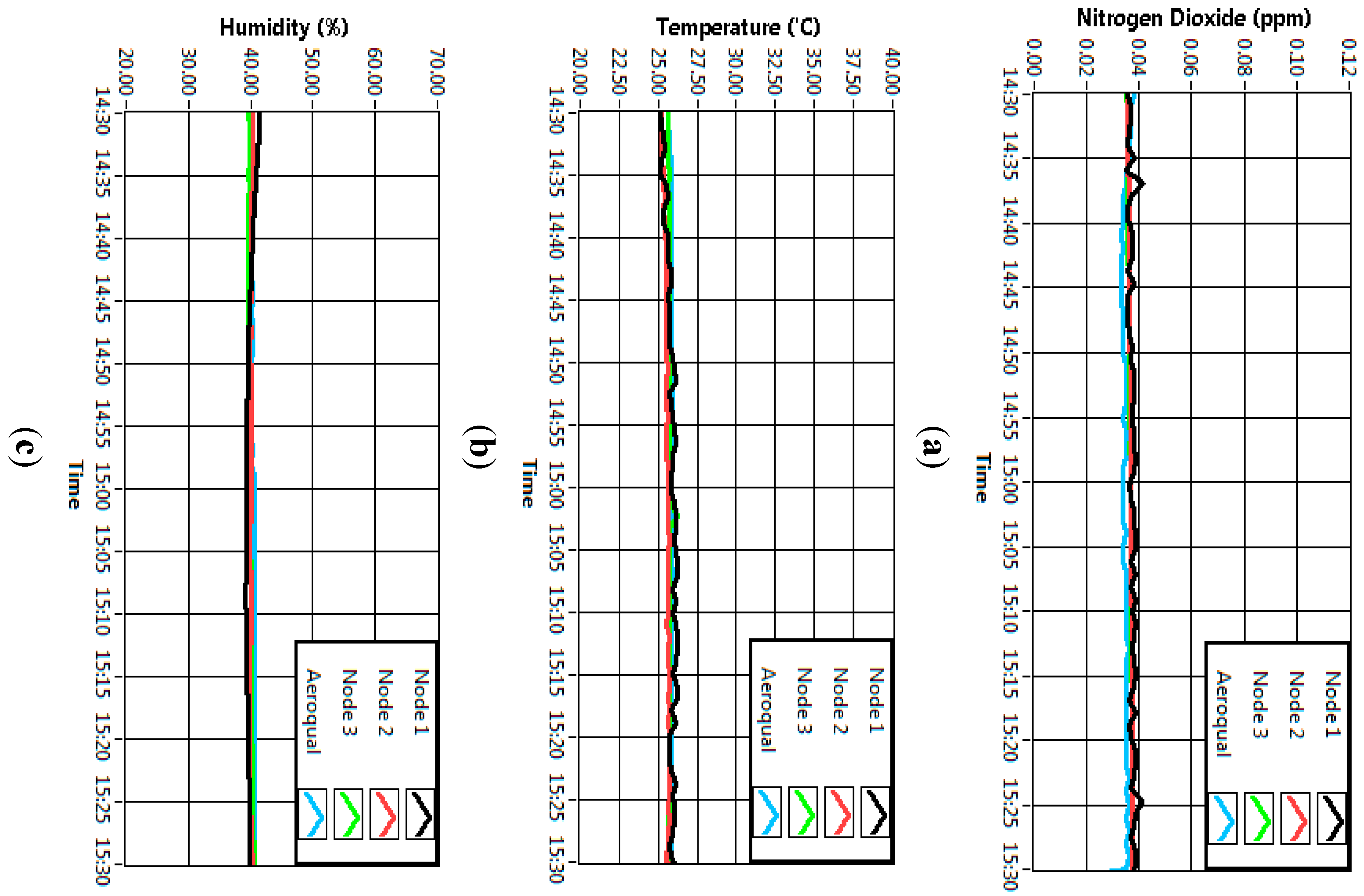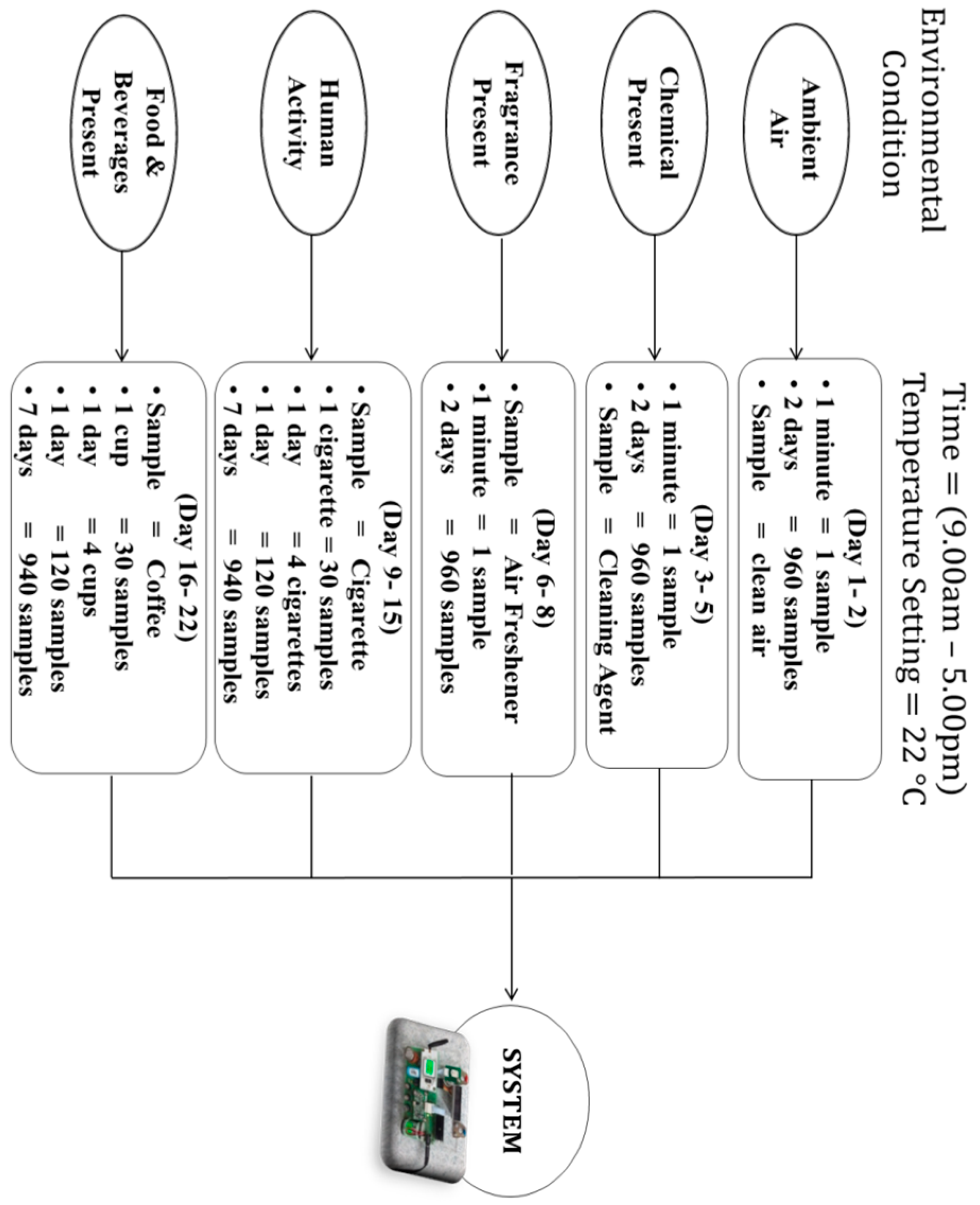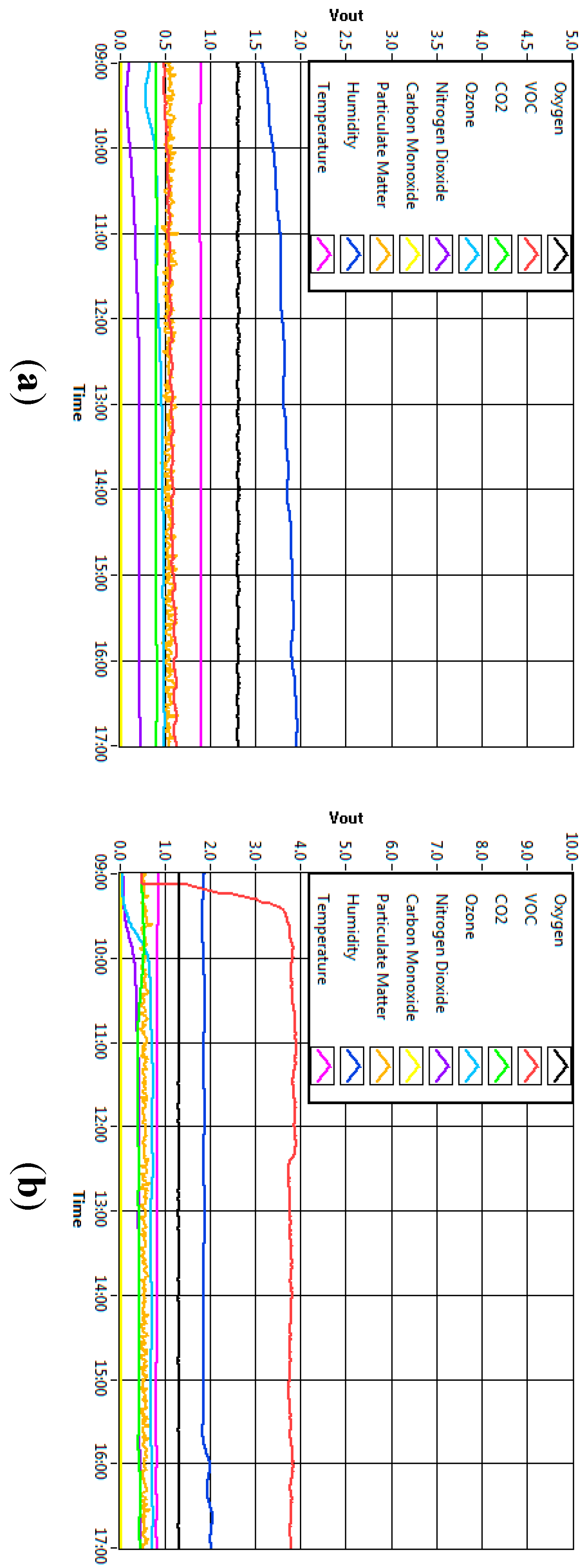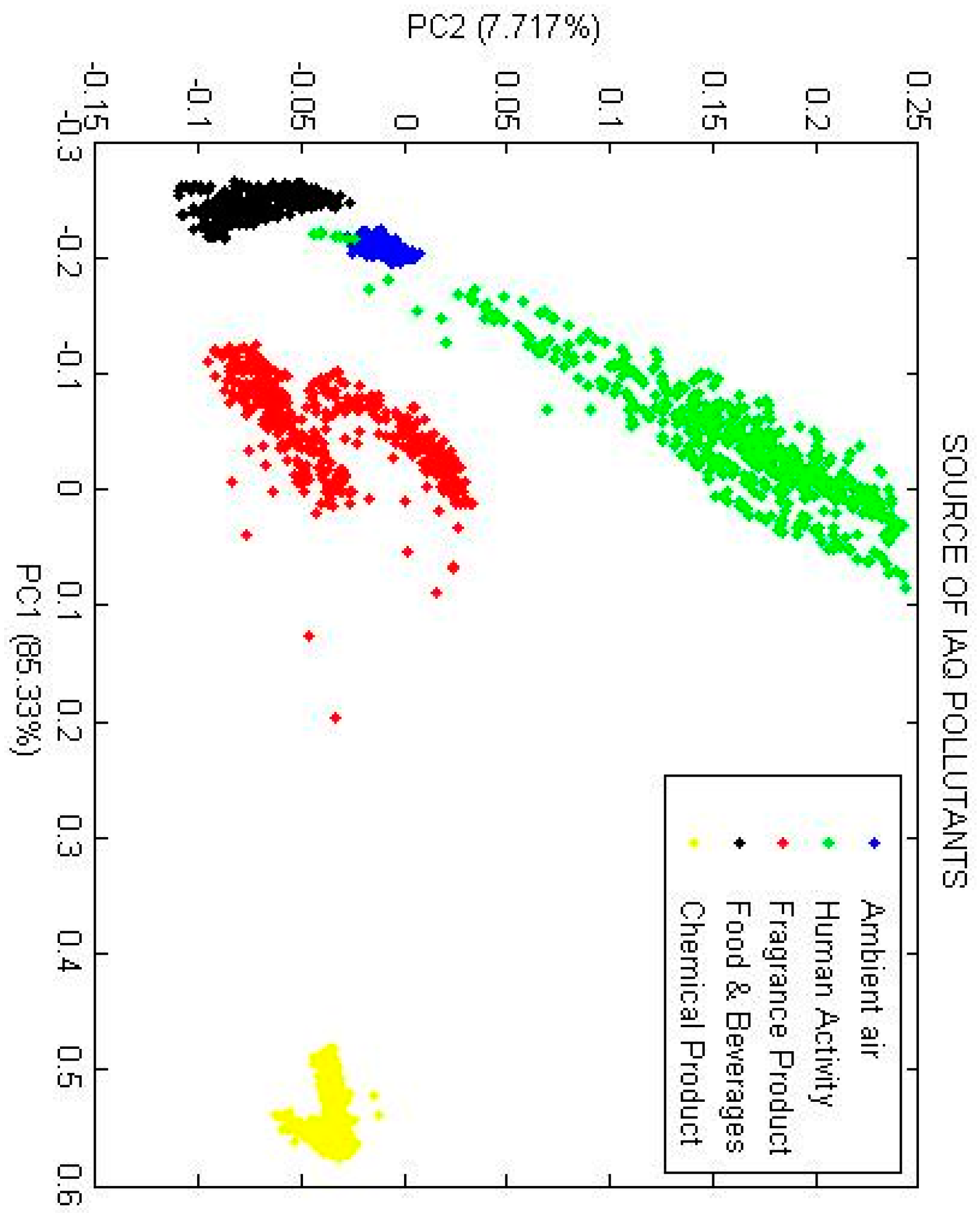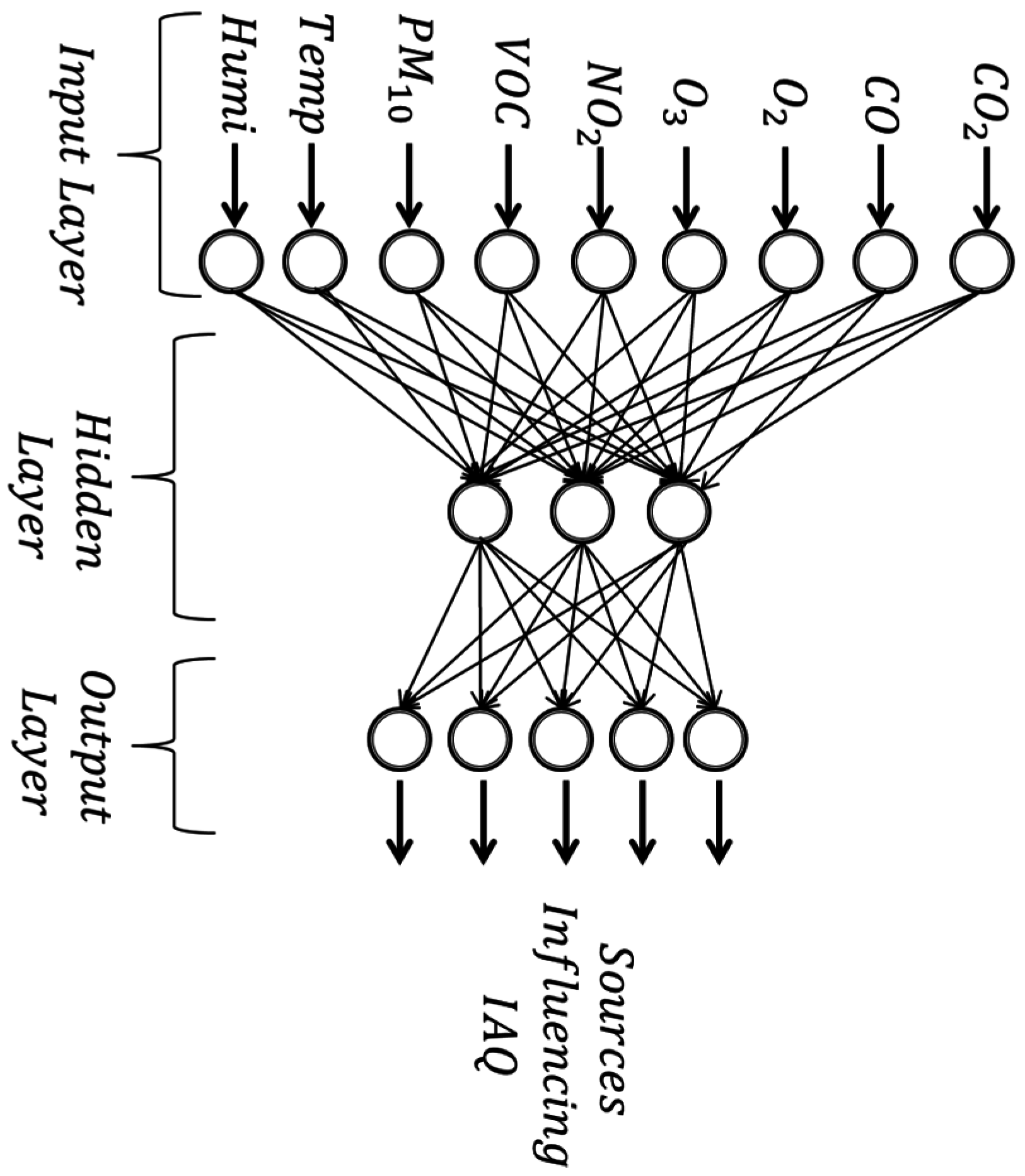The proposed system has been designed in such a way that it is able to monitor air quality in both indoor and outdoor environments. Nine sensors have been used to capture data for the nine parameters required in this project.
Figure 1 shows our proposed system architecture for real time IAQ monitoring. The proposed system consists of sensor module cloud (SMC), base station and service-oriented client. The SMC contains an array of sensor modules that captures the air quality data. The data are then transmitted to the base station through wireless connection where the data are stored in a server. The server functions as data logger to keep track of data received in base station. It stores the data in database, processes the data, performs analysis and provides information about IAQ information through web service. The web service enables the clients or users to be informed about the IAQ level in real-time.
Figure 1.
System architecture for real-time IAQ monitoring.
4.1. Sensor Module
The sensor module is used to sense and measure air quality in indoor environment.
Figure 2 depicts a schematic diagram of the major components of the sensing module. Basically, there are three major components: sensor components, microcontroller and wireless transceiver. This entire component is powered-up by using wall adaptor for continuous power supply.
In this study, a microcontroller unit (MCU) named STC12C5A32S2 with built in 10 Bits Analog-To-Digital Converter (ADC) converts the analogue reading for each sensor response to digital value. STC12C5A32S2 is chosen because this 8-bit microcontroller processes 12 times faster than general 80C51 (it can go up to 35 MHz operation frequency) [
28]. After the conversion of the sampling voltage by ADC, the microcontroller then is responsible for encapsulating the converted data into packets and passing the packets via serial port to the wireless transceiver.
Figure 2.
Block diagram of the sensing node.
Figure 2.
Block diagram of the sensing node.
The wireless transceiver unit transmits the data packets by using Multi-Hop Wireless Sensor Network (WSN) algorithm through the Radio Frequency (RF) chip. Implementation of WSNs in IAQ monitoring has reduced the installation costs due to wire depositions. The IRIS mote from Memsic Company has been selected as the wireless transceiver unit for its low power consumption, low price and complies to the IEEE 802.15.4 wireless protocol [
29]. The operating system used in this mote is based on TinyOS which allows the user to quickly implement the communication network [
30]. In this system, each IRIS mote is responsible to receive data from sensor components through microcontroller. The data from IRIS is sent to the base station. However, if there is another IRIS mote nearer to the base station, the data is sent to its neighbour (the other IRIS mote) before sending the data to the base station. This data transmission process is known as multi-hopping process.
Figure 3 shows the prototype sensor module, consisting of nine gas sensors, and wireless transceiver with microcontroller attached to the wireless transceiver.
Figure 3.
Prototype of sensor module.
Figure 3.
Prototype of sensor module.
The sensor components consist of three types of sensors: gas sensor, particle sensor and thermal sensor. Lists of sensors used in the proposed system along with their operational range are presented in
Table 1 below. Each sensor generates voltage signal based on current environment. These sampling voltage levels are read by microcontroller periodically.
Table 1.
List of sensors used in the system.
Table 1.
List of sensors used in the system.
| No | Sensor Name | Sensor Type | Manufacturer | Target Gas | Typical Detection Range |
|---|
| 1 | CDM 4161 | MOS | Figaro | CO2 | 400–2000 ppm |
| 2 | TGS 5342 | Electrochemical | Figaro | CO | 0–100 ppm |
| 3 | TGS 2602 | MOS | Figaro | VOCs | 0–30 ppm |
| 4 | MiCS-2610 | MOS | SGX Sensortech Limited | O3 | 0.01–1 ppm |
| 5 | MiCS-2710 | MOS | SGX Sensortech Limited | NO2 | 0.01–5 ppm |
| 6 | KE-25 | Electrochemical | Figaro | O2 | 0%–100% |
| 7 | HSM20G | Thermal | GeeTech | Humidity | 20%–95% RH |
| Thermal | Temperature | 0–50 °C |
| 8 | GP2Y1010AU0F | Optical | SHARP | PM10 | 0–0.5 mg/m3 |
Selecting a proper gas sensor is a relatively complicated issue as many factors need to be taken into consideration. For this study, most of the gas sensors are metal oxide based, while the rest are electrochemical based. These Metal Oxide Semiconductor (MOS) sensors contain tin dioxide (SnO
2) sensing element that responds to the gas molecules, which are typically volatile compounds [
31]. It consists of two major parts, namely the heater and sensor substrate. The substrate has two terminals and its resistance is measured as a representation of the amount of gas concentration in the environment while the heater provides the stabilized temperature needed for the measurement [
32]. Due to its long lifetime, high sensitivity response and low cost, this type of sensor is commonly used in many indoor applications such as homes, offices and factories appliances. The second type of gas sensor used in this study is electrochemical based sensor. This type of sensor has high sensitivity to environmental change and it does not need power to operate.
However, this type of sensor has its limitations. These low cost sensors cannot provide accurate readings of the gas presence in the air since they are strongly affected by the temperature, humidity and the presence of other gases. To compensate this limitation, the patterns are observed instead of the actual data measured. The sensor resistance and the gas concentration in the environment interact in the following expression.
where
Rs is the sensor resistance of the sensor,
A is constant,
C is the gas concentration and α is the slope of
Rs curve [
33].
To detect the physical contaminant like dust or particulate matter, Sharp GP2Y1010 optical dust sensor from Sharp has been chosen. This sensor contains an infrared emitting diode and a phototransistor which are arranged diagonally. Any dust that gets into the sensor makes the infrared light reflect which can be detected by phototransistor. The advantage of this dust sensor is it can detect small particles like cigarette smoke. It is commonly used in an air purifier system because it is small, cheap, robust and uses low current consumption [
34]. For thermal sensor, HSM-20G sensor is used to detect temperature and humidity. HSM-20G is an analog sensor that converts the ambient temperature and relative humidity into standard output voltages (1–3.3 V). It can measure the temperature between the ranges of 0–50 °C. It is also able to detect the relative humidity (RH) from 20% to 95% with accuracy ±0.5% at 25 °C [
35]. With the calibration curve provided in the datasheet, these analog voltages can be converted to the unit of temperature (°C) and relative humidity (%).
4.3. Service-Oriented Client
Service-oriented client provides all information on IAQ accessible in real-time. The data is shared through self-developed Graphical User Interface (GUI). The GUI is the interface that facilitates the users to interact with the programs. In this research, the GUI was developed by using LABVIEW software program. In order to stream sensor data for web service that was located in the server, the GUI adopted websocket technology.
Figure 5 shows the visual of GUI that has been developed.
This GUI provides a map location of the sensor modules which are placed at different locations such as meeting room, lecture room and postgraduate room (this study uses CEASTech Institute in UNIMAP, Perlis as its base location). It also provides the current value IAQ parameters with color-coded graph based on IAQ index level. The system receives the data in the forms of voltages. These voltages are compared to the specified ANN output model that has been trained and then the data are classified according to the training set (any one of the five categories trained). The GUI then displays the information of the source of activity influencing IAQ level.
Figure 5.
GUI visualization for IAQ monitoring system.
Figure 5.
GUI visualization for IAQ monitoring system.

